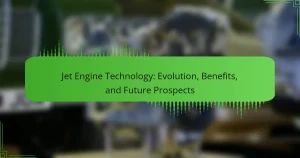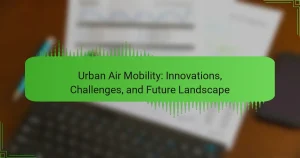Electric trains offer significant advancements in efficiency and sustainability. Innovations include improved battery technology, lightweight materials, and regenerative braking systems. These developments enhance energy efficiency, reduce emissions, and promote cleaner air. Leading regions like China, Europe, and Japan are pioneering electric train infrastructure, showcasing unique models tailored for various operational needs.
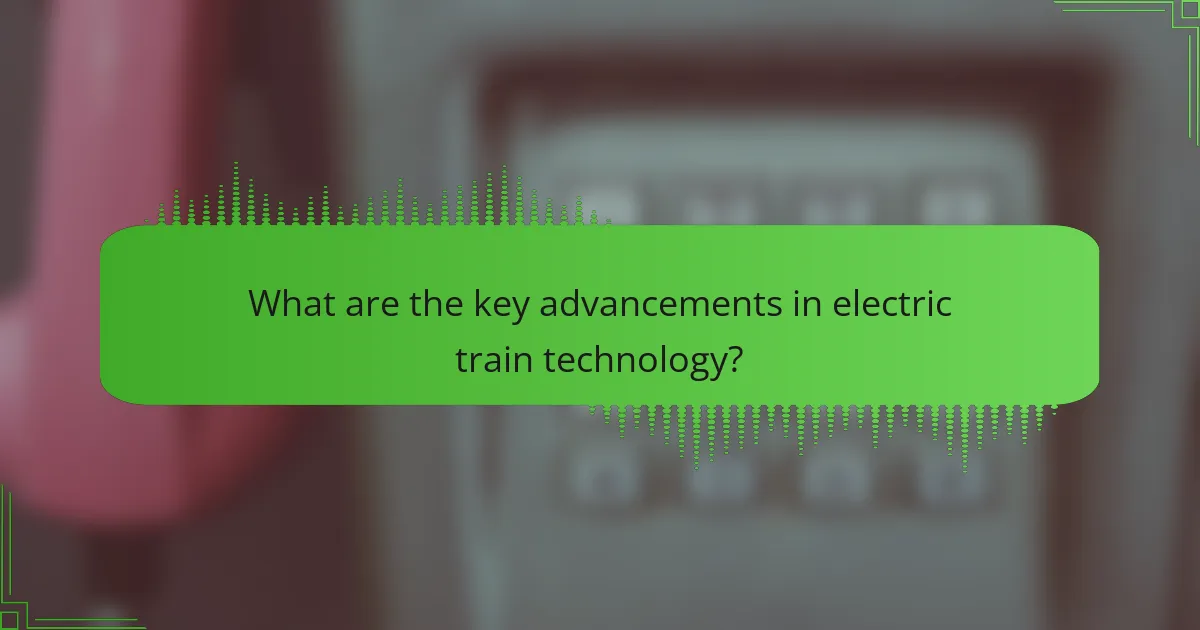
What are the key advancements in electric train technology?
Electric train technology has seen significant advancements, focusing on efficiency and sustainability. Key developments include improved battery technology, which enhances energy storage and reduces charging time. Innovations in lightweight materials have led to increased speed and reduced energy consumption. Additionally, advancements in regenerative braking systems allow trains to recover energy during braking, further enhancing efficiency. Overall, these innovations contribute to a more sustainable and efficient rail transport system.
How has battery technology improved electric train performance?
Battery technology has significantly enhanced electric train performance through increased energy density and faster charging. Modern lithium-ion batteries offer higher capacity, enabling longer travel distances without recharging. Improved thermal management systems also enhance battery life and efficiency. Additionally, regenerative braking technology recovers energy during braking, further optimizing performance. These advancements contribute to reduced operational costs and lower environmental impact, making electric trains a more sustainable transportation option.
What role does automation play in modern electric trains?
Automation significantly enhances the efficiency and safety of modern electric trains. It enables precise control of train operations, reducing human error and optimizing schedules. Automated systems manage acceleration, braking, and energy consumption, leading to energy savings and improved performance. For instance, advanced signaling technology allows for real-time monitoring and communication, enhancing safety and reducing delays. Overall, automation is integral to the evolution of electric trains, contributing to a more sustainable transportation system.
Which innovations are enhancing the speed and efficiency of electric trains?
Innovations enhancing the speed and efficiency of electric trains include advanced traction systems, lightweight materials, and regenerative braking technology. These developments improve acceleration, reduce energy consumption, and increase overall performance. For instance, the integration of AI for predictive maintenance optimizes operational efficiency and minimizes downtime. Additionally, the use of high-speed rail technology allows trains to reach speeds exceeding 300 km/h, significantly reducing travel times.
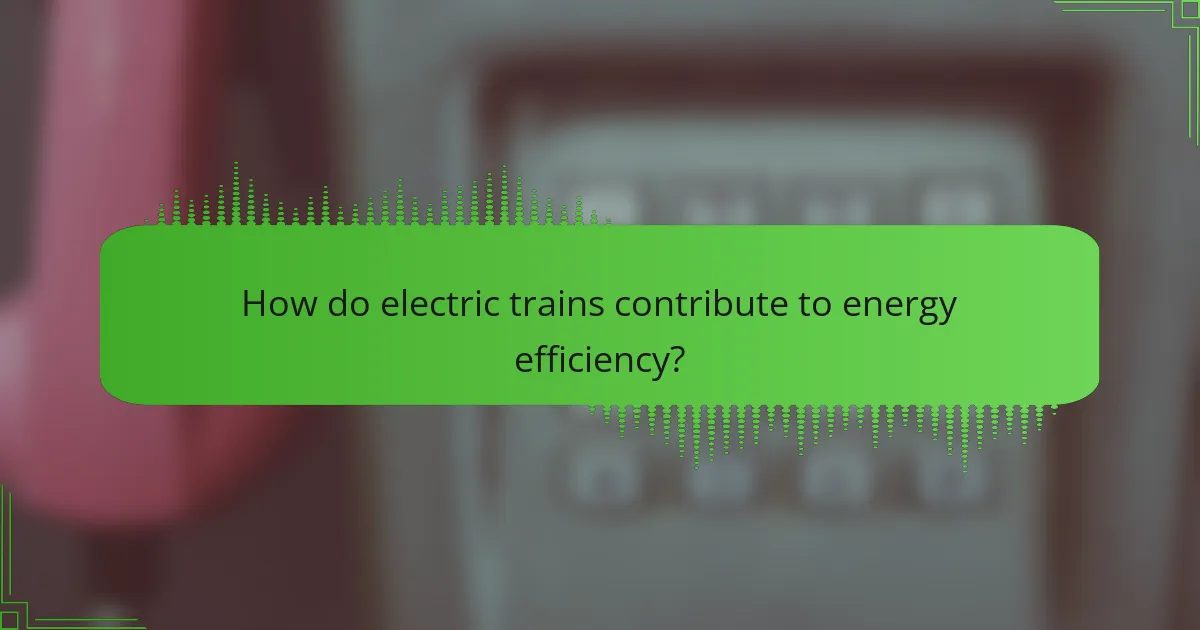
How do electric trains contribute to energy efficiency?
Electric trains significantly enhance energy efficiency by utilizing electric power instead of fossil fuels. They convert over 90% of energy into movement, minimizing energy loss. Electric trains also benefit from regenerative braking, which recovers energy during deceleration. This technology reduces overall energy consumption and promotes sustainability. Additionally, electric trains can be powered by renewable energy sources, further decreasing their carbon footprint. Their operational efficiency and lower emissions highlight their role in advancing sustainable transportation.
What are the energy consumption metrics of electric trains compared to diesel?
Electric trains consume significantly less energy compared to diesel trains, enhancing their efficiency and sustainability. Electric trains typically operate with an energy consumption metric of around 0.5 to 1.5 kWh per kilometer, while diesel trains average between 2 to 4 kWh per kilometer. This stark difference highlights the advantages of electric traction in reducing overall energy consumption.
| Train Type | Energy Consumption (kWh/km) |
|——————|—————————–|
| Electric Trains | 0.5 – 1.5 |
| Diesel Trains | 2 – 4 |
The reduced energy consumption of electric trains leads to lower operational costs and decreased greenhouse gas emissions, making them a more sustainable choice for rail transport. Additionally, advancements in electric train technology continue to improve their efficiency and performance, further solidifying their role in sustainable transportation.
How does regenerative braking improve energy efficiency in electric trains?
Regenerative braking significantly enhances energy efficiency in electric trains by converting kinetic energy back into electrical energy. This process reduces energy consumption during braking, allowing trains to recharge their batteries or supply power to other systems. As a result, electric trains can operate with lower energy costs and reduced emissions, contributing to sustainability. The ability to recover up to 30% of the energy used during acceleration exemplifies the efficiency of this technology.

What are the environmental benefits of using electric trains?
Electric trains significantly reduce environmental impact through lower emissions, energy efficiency, and reduced noise pollution. They produce minimal greenhouse gases compared to diesel trains, contributing to cleaner air. Electric trains utilize regenerative braking, which recycles energy, enhancing overall efficiency. Additionally, they operate quietly, minimizing noise pollution in urban areas. This combination of factors leads to a more sustainable transportation option, promoting ecological preservation and public health.
How do electric trains reduce greenhouse gas emissions?
Electric trains significantly reduce greenhouse gas emissions by utilizing electricity instead of fossil fuels. This shift leads to lower carbon dioxide output, especially when the electricity is sourced from renewable energy. Additionally, electric trains are more energy-efficient than diesel counterparts, consuming less energy per passenger mile. As a result, they contribute to cleaner air and a smaller carbon footprint in transportation.
What impact do electric trains have on urban air quality?
Electric trains significantly improve urban air quality by reducing greenhouse gas emissions and particulate matter. Their electric propulsion eliminates exhaust emissions, leading to cleaner air in cities. Studies show that cities with electric train systems experience lower levels of air pollutants compared to those relying on diesel or gasoline-powered transport. Additionally, electric trains often utilize renewable energy sources, further enhancing their environmental benefits. As urban areas grow, the adoption of electric trains can play a crucial role in achieving sustainable urban mobility and improving public health.
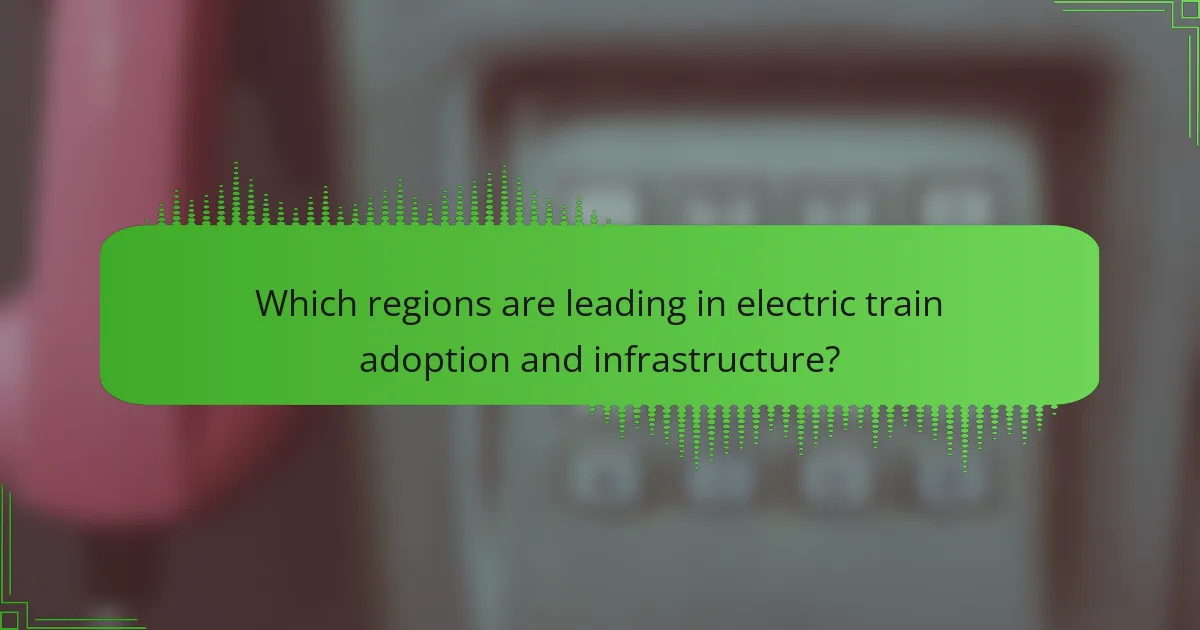
Which regions are leading in electric train adoption and infrastructure?
China, Europe, and Japan are leading in electric train adoption and infrastructure development. China has the largest high-speed rail network, with over 40,000 kilometers of electrified tracks. Europe follows with significant investments in electric rail systems, particularly in countries like Germany and France. Japan’s Shinkansen remains a model for efficiency and sustainability, showcasing advanced technology in electric train systems. These regions prioritize electrification to reduce carbon emissions and enhance public transport efficiency.
What are the challenges faced by countries transitioning to electric rail systems?
Countries transitioning to electric rail systems face several significant challenges. These include high initial infrastructure costs, the need for technological upgrades, and regulatory hurdles.
Funding is a crucial barrier; many nations struggle to secure the necessary investments for electrification projects. Additionally, existing rail networks may require extensive modifications to accommodate electric trains, which can lead to prolonged disruptions.
Technological challenges arise from integrating new systems with legacy infrastructure. Countries must also ensure that the electricity supply is reliable and sustainable, often requiring the development of renewable energy sources.
Finally, regulatory and policy frameworks must evolve to support these transitions, which can be a slow and complex process.
How do cultural attitudes towards public transport influence electric train implementation?
Cultural attitudes towards public transport significantly influence the implementation of electric trains. Societies that prioritize sustainability and efficiency tend to support electric train systems. For example, countries with strong environmental values often invest in electric train infrastructure to reduce carbon emissions. Public perception of convenience and reliability also affects adoption rates. In regions where public transport is viewed positively, electric trains are more likely to receive funding and political support. Conversely, areas with skepticism towards public transport may face challenges in integrating electric train systems.
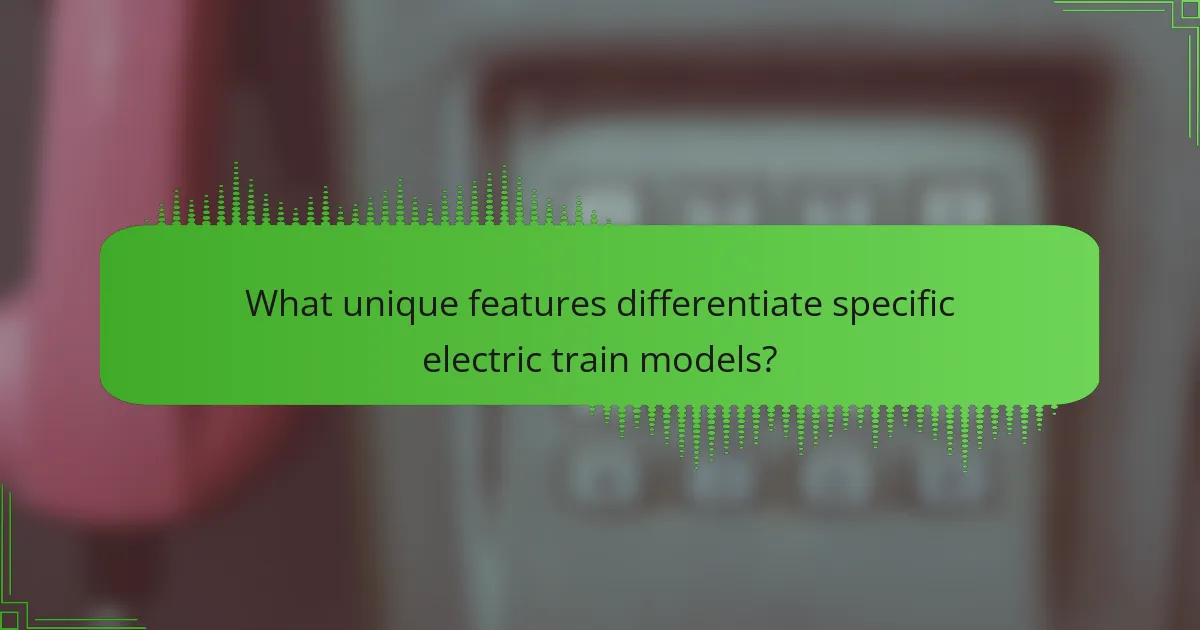
What unique features differentiate specific electric train models?
Specific electric train models are distinguished by unique features such as speed, energy efficiency, and advanced technology. For instance, the Siemens Velaro boasts a maximum speed of 300 km/h and regenerative braking, enhancing energy efficiency. In contrast, the Bombardier Zefiro is known for its lightweight design and modularity, allowing for various configurations. The Alstom AGV features a tilting mechanism for improved passenger comfort on curves. Each model’s unique attributes cater to different operational needs and regional requirements.
Which electric train models are known for their innovative designs?
Electric train models known for innovative designs include the Siemens Velaro, Bombardier Zefiro, and Alstom AGV. These models showcase advancements in aerodynamics, energy efficiency, and passenger comfort.
The Siemens Velaro features a streamlined shape that reduces drag, enhancing speed and efficiency. Bombardier’s Zefiro incorporates lightweight materials and regenerative braking, contributing to sustainability. Alstom’s AGV stands out with its modular design, allowing for flexibility in configurations and improved maintenance.
These innovations reflect the industry’s commitment to enhancing performance while minimizing environmental impact.
What are the standout characteristics of high-speed electric trains?
High-speed electric trains are characterized by their exceptional speed, energy efficiency, and reduced environmental impact. They can reach speeds exceeding 300 km/h, significantly shortening travel times. These trains utilize advanced aerodynamics, lightweight materials, and regenerative braking systems, enhancing performance and sustainability. Their electric propulsion minimizes greenhouse gas emissions compared to traditional diesel trains, supporting eco-friendly transportation solutions.
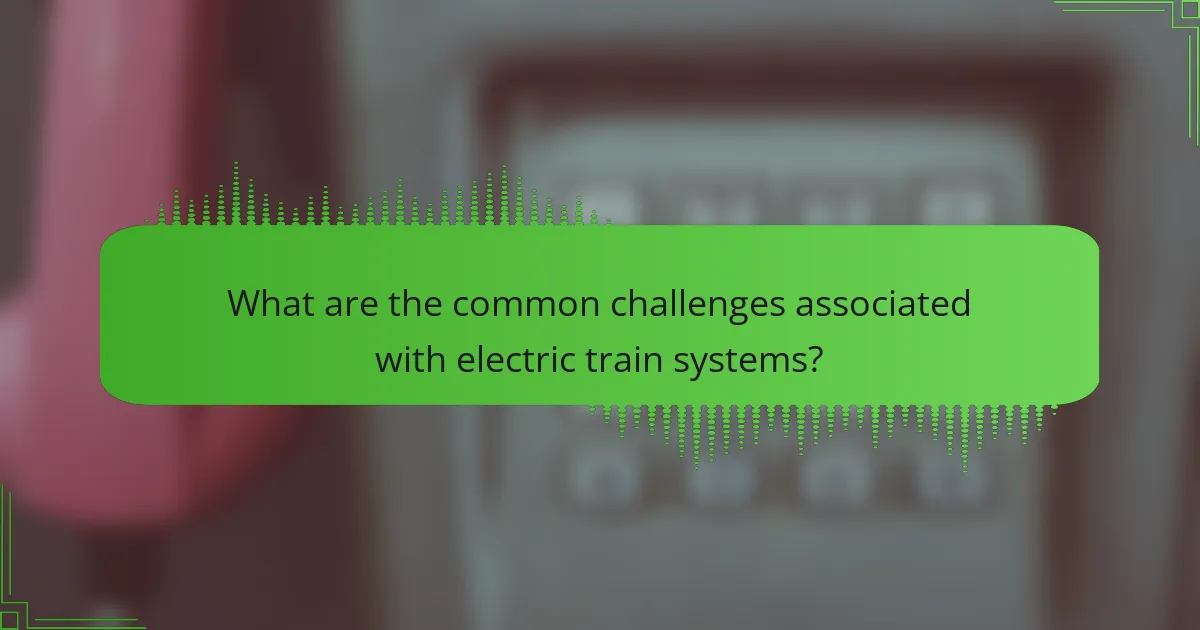
What are the common challenges associated with electric train systems?
Electric train systems face several common challenges that impact their efficiency and sustainability. Key issues include high initial infrastructure costs, limited charging station availability, and the need for advanced technology integration. Additionally, electric trains often encounter operational constraints due to varying power supply reliability and maintenance complexities. Lastly, environmental factors, such as weather conditions, can affect performance and safety.
How do maintenance costs compare between electric and traditional trains?
Electric trains generally have lower maintenance costs compared to traditional trains due to fewer moving parts and less wear on components. Electric trains benefit from advanced technology that enhances efficiency and reduces the frequency of repairs.
Electric trains typically require less maintenance because they do not have complex mechanical systems like diesel engines. For instance, the absence of oil changes and reduced brake wear contribute to overall savings.
In contrast, traditional trains often incur higher maintenance costs due to their reliance on combustion engines and more extensive mechanical systems. This results in more frequent servicing and parts replacement.
Overall, the shift toward electric trains represents a significant opportunity for cost savings in maintenance, aligning with sustainability goals and operational efficiency.
What infrastructural limitations affect electric train expansion?
Infrastructural limitations such as outdated rail networks, insufficient electrification, and limited station capacity hinder electric train expansion. These factors restrict operational efficiency and the ability to integrate new technologies. Additionally, high initial investment costs and regulatory challenges further complicate expansion efforts.
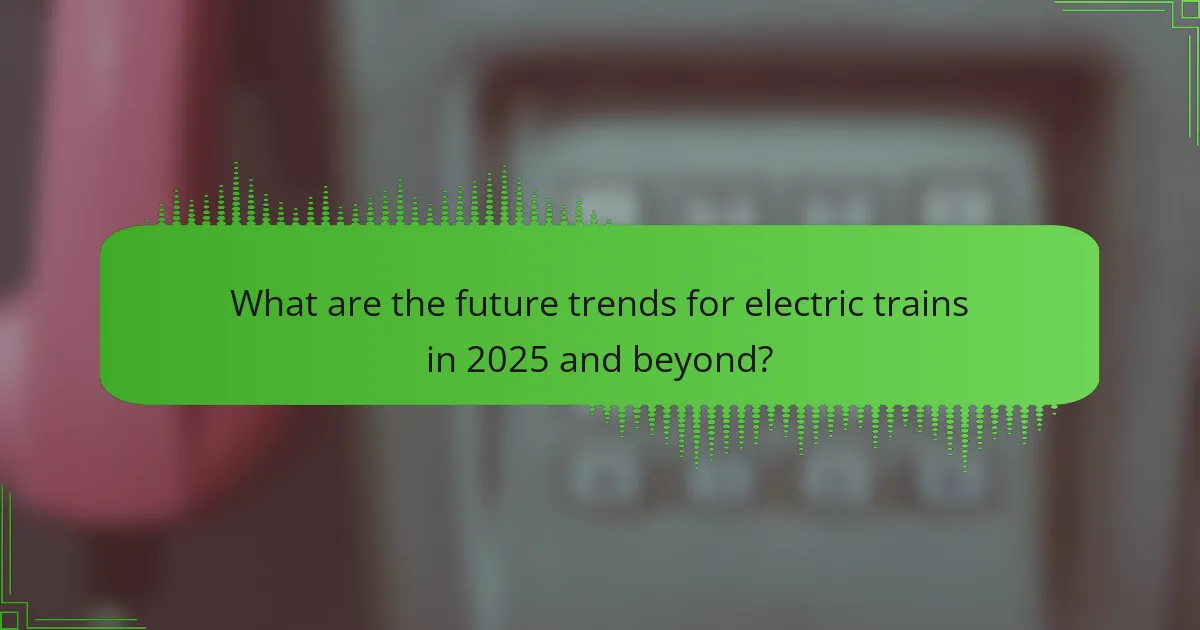
What are the future trends for electric trains in 2025 and beyond?
Electric trains will increasingly feature advanced battery technologies, enhanced efficiency, and sustainable energy sources by 2025. Innovations like hydrogen fuel cells and improved electrification methods will reduce carbon footprints. Smart train systems will optimize energy use and maintenance, promoting operational sustainability. Integration with renewable energy sources will further enhance their environmental benefits.
Which technologies are expected to revolutionize electric train travel?
Innovative technologies expected to revolutionize electric train travel include battery advancements, hydrogen fuel cells, and smart train systems. These technologies enhance efficiency, reduce emissions, and improve passenger experience.
Battery advancements enable longer travel distances and faster charging times. Hydrogen fuel cells offer a zero-emission alternative, utilizing hydrogen to power trains. Smart train systems incorporate AI and IoT for optimized scheduling and energy management.
As a result, these technologies collectively contribute to sustainable and efficient electric train travel, aligning with global environmental goals.
How will electric trains adapt to changing passenger needs?
Electric trains will adapt to changing passenger needs through enhanced technology, improved comfort, and sustainability initiatives. Innovations like real-time tracking and on-demand services will personalize travel experiences.
Additionally, electric trains will incorporate features such as larger seating areas, charging stations, and Wi-Fi, responding to passenger preferences for convenience. As a result, the shift towards eco-friendly travel will drive the adoption of renewable energy sources, making electric trains a more sustainable choice.
These advancements not only meet current demands but also prepare for future trends in urban mobility. By focusing on efficiency and passenger-centric design, electric trains will remain a vital part of modern transportation.
What best practices can be implemented for optimizing electric train systems?
Implementing best practices for optimizing electric train systems enhances efficiency and sustainability. Key strategies include adopting regenerative braking, which recovers energy during deceleration, reducing overall energy consumption. Integrating advanced signaling systems improves train scheduling and minimizes delays. Regular maintenance ensures optimal performance and longevity of components. Utilizing lightweight materials in train construction enhances speed and energy efficiency. Implementing real-time data analytics enables proactive decision-making for operational improvements.

